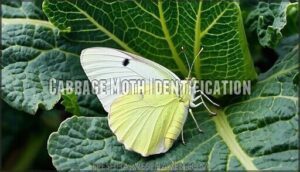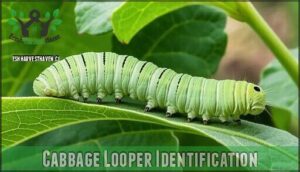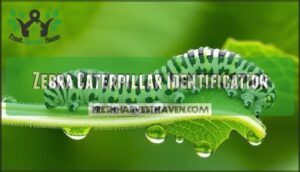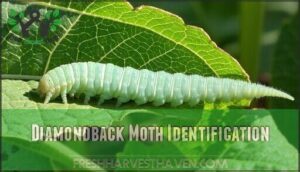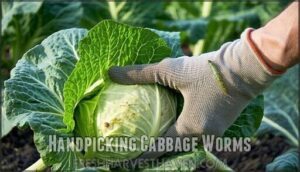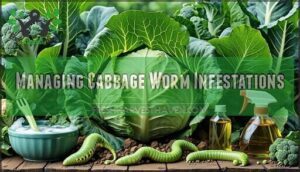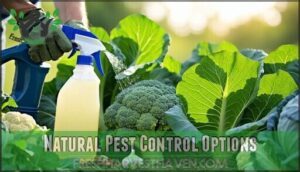This site is supported by our readers. We may earn a commission, at no cost to you, if you purchase through links.

Start with handpicking – it’s surprisingly therapeutic and immediately effective. Row covers create a physical barrier during peak moth activity, while companion plants like dill and nasturtiums naturally repel pests.
Encourage beneficial predators such as parasitic wasps and birds to patrol your garden. Organic sprays using Bt (Bacillus thuringiensis) target caterpillars specifically without affecting other insects.
Diatomaceous earth creates a hostile environment for crawling pests, and neem oil disrupts their feeding patterns. These methods work best when combined strategically, creating multiple defense layers that keep your brassicas pristine while maintaining your garden’s natural balance.
Table Of Contents
- Key Takeaways
- Cabbage Worm Identification
- Organic Control Methods
- Preventing Cabbage Worms
- Managing Cabbage Worm Infestations
- Natural Pest Control Options
- Frequently Asked Questions (FAQs)
- How to treat cabbage worms organically?
- How to get rid of a cabbage worm?
- What is the best natural spray for cabbage worms?
- What herbs keep cabbage worms away?
- When should I start checking for eggs?
- Can cabbage worms survive winter temperatures?
- Do cabbage worms affect plant nutrition?
- How long after harvest are plants safe?
- Are there weather conditions that reduce infestations?
- Conclusion
Key Takeaways
- Handpick regularly – You’ll get immediate results by manually removing worms and eggs from leaf undersides, especially during the early morning when they’re most active.
- Use physical barriers – Install row covers right after transplanting to prevent cabbage moths from reaching your plants and laying eggs in the first place.
- Encourage beneficial predators – Attract parasitic wasps, ladybugs, and lacewings by planting dill, fennel, and yarrow nearby to create natural population control.
- Apply targeted organic sprays – Use Bt (Bacillus thuringiensis) or neem oil during the early larval stages for maximum effectiveness without harming beneficial insects.
Cabbage Worm Identification
You’ll need to identify the specific type of cabbage worm attacking your plants before choosing the most effective organic control method.
Each species has distinct characteristics that help determine the best treatment approach, from the fuzzy green imported cabbage worm to the looping movement of cabbage loopers.
Cabbage Worm Life Cycle
Understanding the cabbage worm life cycle helps you target these pests effectively.
The complete cycle spans 3-6 weeks, starting when adults lay eggs on leaf undersides.
Egg hatching occurs within days, releasing tiny larvae that feed through five larval stages over 15 days.
Pupal development follows for 11 days before adults emerge with a 3-week adult lifespan.
Multiple generational cycles occur seasonally—2-3 in colder climates, up to 12 in warmer regions.
Cabbage Moth Identification
Adult Cabbage White butterflies are the culprits behind cabbage worm infestations.
These pale-yellow winged insects display distinct Sexual Dimorphism – females sport white-haired bodies while males have darker ones.
Male and female cabbage moths reveal their secrets through distinctive body coloring and wing markings.
Their Wing Patterns** feature faint black spots that help with identification.
Watch for Moth Behavior like erratic flight patterns around brassicas during daylight hours.
Cabbage moths lay distinctive white or yellow oblong eggs on leaf undersides, making Egg Identification essential for early intervention.
Cabbage Looper Identification
While cabbage worms are green and fuzzy, cabbage looper caterpillars move with their distinctive "looping" motion that sets them apart.
These yellow-green larvae lack middle legs, causing them to arch their backs when crawling like inchworms. You’ll spot their smooth bodies measuring up to 1.5 inches long, with thin white stripes running down their sides.
Their erratic movement pattern makes looper identification straightforward compared to other cabbage worms. Employing sticky traps can further aid in their detection.
Zebra Caterpillar Identification
Black and white zebra markings make these caterpillars easy to spot on your brassica plants.
Unlike typical cabbage worms, zebra caterpillars display distinctive striped patterns with green accents across their bodies.
These brassica pests feed on the same host plants but eventually transform into American noctuid moths through their caterpillar stages.
What makes zebra caterpillars stand out:
- Bold zebra markings create a striking contrast against green leaves, making detection easier than camouflaged cabbage worms
- Voracious caterpillar diet means they’ll munch through kale, broccoli, and cabbage just as aggressively as other pests
- Rapid growth through caterpillar stages allows them to cause significant damage before you notice the problem
- Adult noctuid moths emerge to lay more eggs, creating cycles that challenge organic pest control efforts
Diamondback Moth Identification
You’ll recognize diamondback moth larvae by their distinctive pale green color and forked tail.
These caterpillars wriggle violently when disturbed, unlike other brassica pests that remain still.
The diamondback moth creates diamond-shaped patterns on its wings, making adult identification straightforward for effective Bacillus thuringiensis treatment timing.
| Feature | Larval Appearance | Adult Markings |
|---|---|---|
| Size | 8-12mm long | 15mm wingspan |
| Color | Pale green body | Gray-brown wings |
| Distinguishing Marks | Forked tail, sparse hairs | Diamond wing patterns |
| Behavior | Vigorous wiggling | Night-flying moth |
Organic Control Methods
When cabbage worms invade your garden, you don’t need harsh chemicals to fight back effectively.
These organic methods work by targeting the pests at different life stages while protecting your plants and beneficial insects naturally.
Handpicking Cabbage Worms
Grab your gloves and start your daily patrol—handpicking pests remains the most reliable method for manual removal of cabbage worms.
Focus your search on leaf undersides where larvae hide, and watch for telltale frass detection clues.
Here’s your systematic approach:
- Timing Matters – Inspect plants early morning when worms are most active
- Underside Focus – Check leaf undersides thoroughly for hidden larvae
- Egg Removal – Crush yellowish eggs before they hatch into hungry caterpillars
- Tool Usage – Use tweezers for precise hand removal without damaging plants
Using Row Covers
Beyond handpicking, floating row covers create an impenetrable barrier against cabbage moths. Install these lightweight fabrics immediately after transplanting, securing edges with soil or clips. You’ll need to remove covers during flowering for pollination, but most brassicas don’t require this step.
Companion planting, a form of natural pest control, can also help manage infestations.
| Row Cover Types | Best Uses |
|---|---|
| Spun fabric | Season-long protection, allows rain through |
| Mesh covers | Hot weather use, maximum ventilation needs |
| Plastic sheeting | Cold protection, requires daily removal |
| Insect netting | Lightweight summer option, pest-specific |
| Heavyweight fabric | Winter protection, blocks most light |
Proper installation timing matters – cover plants before pest arrival in spring. Maintain adequate ventilation by avoiding tight wrapping. Check crop compatibility since some vegetables need pollinator access.
Maintain covers by inspecting for tears and cleaning debris weekly, and verify that they’re in good condition to guarantee their effectiveness.
Companion Planting
Strategic companion planting creates a living shield around your brassica family crops, turning your garden into a fortress against cabbage worms.
Marigolds and thyme act as natural repelling pests agents, masking cabbage scents that attract moths.
Plant nasturtiums as trap crops to lure worms away from your main harvest.
This polyculture approach reduces pesticide needs by 40% while attracting predators and improving growth through enhanced soil health.
Natural Predators
Natural predators offer your garden’s most effective biological control against cabbage worms.
These beneficial insects work tirelessly to reduce pest populations:
- Parasitic wasps like Trichogramma wasps lay eggs inside cabbage worm larvae, killing them from within
- Ladybugs consume dozens of eggs and young larvae daily, providing excellent population control
- Lacewings devour cabbage worm eggs voraciously, preventing future infestations
Attracting predators requires planting flowering species like dill and fennel nearby, creating habitat diversity that supports these natural allies in your pest management strategy.
Organic Sprays
When dealing with persistent cabbage worm infestations, organic sprays offer effective backup solutions.
DIY sprays mixing soap and water target soft-bodied larvae, while BT options containing Bacillus thuringiensis specifically kill caterpillars without harming beneficial insects.
Oil sprays smother eggs and young worms, and many gardeners find success using cabbage-specific treatments.
Application tips include evening timing for best results in organic gardening.
Preventing Cabbage Worms
Prevention remains your strongest defense against cabbage worm infestations, requiring strategic planning before pests arrive.
You’ll need to implement multiple preventative measures that work together to create an environment where cabbage moths can’t successfully establish populations in your garden, which is your strongest defense.
Planting Resistant Varieties
Purple and red cabbage varieties naturally resist cabbage worms better than standard green types.
Their anthocyanin content makes them less appealing to pests while providing superior visibility for spotting any remaining worms.
When selecting pest-resistant plants for your organic gardening approach, these colorful varieties offer dual benefits: reduced infestations and easier monitoring compared to traditional cabbage family crops, with superior visibility.
Crop Rotation
Rotating crops disrupts cabbage worms’ life cycles by removing their preferred brassica hosts. You’ll break pest reproduction patterns while improving soil health and nutrient cycling.
This practice reduces pest populations, enhances weed control, and increases yield potential for future plantings. One key element is to boost soil fertility for ideal growth.
- Plant legumes after cruciferous vegetables to restore nitrogen levels
- Follow heavy feeders like cabbage with light feeders like herbs
- Rotate brassica crops to different garden sections each season
- Allow 2-3 years between planting cruciferous vegetables in same location
Sanitation
Keep your garden clean to prevent cabbage worm infestations. Remove debris from around plants regularly, as fallen leaves and plant residue can harbor overwintering pests.
Practice proper tool sanitation by cleaning garden tools between plants to avoid spreading eggs. Maintain soil health through proper compost management, ensuring decomposed organic matter doesn’t contain pest eggs.
Good garden hygiene supports effective cabbage worm control and organic pest management strategies, which is crucial for proper compost management.
Trapping Cabbage Moths
Trapping cabbage moths disrupts their reproductive cycle before they can lay eggs on your plants.
Pheromone traps attract males using species-specific lures, while light traps capture moths during nighttime activity. Strategic trap placement near flight paths maximizes effectiveness.
These traps are effective at controlling moth populations.
- Sticky traps baited with pheromone lures positioned upwind from cabbage patches
- UV light traps placed at garden perimeters to intercept incoming moths
- Mustard plants serving as trapcropping stations to lure moths away from main crops
Using Decoy Moths
Decoy butterflies exploit moth territoriality by convincing cabbage white butterflies that your garden’s already occupied.
These visual deterrents can reduce egg-laying by up to 60% when placed strategically near crops.
However, species specificity matters—different cabbage moths require targeted decoy types.
Effective placement strategies involve positioning decoys at crop edges before peak moth activity for maximum cabbage worm control.
Effective use of these decoys can lead to better moth territoriality management in gardens.
Managing Cabbage Worm Infestations
Once you spot the telltale signs of cabbage worm damage, you’ll need to act quickly to prevent these hungry caterpillars from destroying your entire brassica crop.
Managing an active infestation requires a systematic approach that combines immediate removal techniques with ongoing monitoring to keep populations under control.
Monitoring Plant Damage
Spotting cabbage worms early makes all the difference in protecting your crops.
Check your brassica plants twice weekly for telltale signs: small holes between leaf veins, dark green frass (larvae droppings), and actual green caterpillars hiding on leaf undersides.
Young seedlings face the greatest vulnerability since even minor damage can stunt growth substantially.
On mature plants, leaf damage might seem cosmetic but can reduce crop marketability if left unchecked.
Controlling Cabbage Worms
Once you’ve spotted worm damage, swift action prevents further plant health deterioration.
Organic solutions work effectively when applied consistently:
- BT (Bacillus thuringiensis) – This natural insecticide targets cabbage worms specifically without harming beneficial insects
- Preventative measures – Regular inspections help catch infestations before they escalate
- Natural predators – Encourage birds and parasitic wasps for ongoing organic control
Removing Infested Plants
Sometimes heavily infested plants become beyond saving, making plant disposal your best option.
When cabbage worms have caused extensive plant damage through manual removal attempts, removing entire plants prevents disease spread and protects soil health in your organic garden.
To combat these pests, gardeners often turn to natural control methods.
| Assessment Factor | Action Required |
|---|---|
| Severe leaf damage (>70% consumed) | Remove entire plant immediately |
| Multiple generations present | Dispose of plant, avoid composting risks |
| Stunted growth from repeated attacks | Clear area for replanting options |
| Contamination from excessive frass | Conduct thorough garden inspection |
Using Physical Barriers
Row covers create an impenetrable fortress against cabbage worms by blocking adult moths from reaching your plants.
Install floating row covers immediately after transplanting, ensuring proper mesh size matters for airflow while preventing pest entry.
Secure barriers with soil barrier methods or plant collars use around individual plants. For various options, consider garden row covers.
Remove covers during flowering for pollination, then reinstall for continued garden pests protection throughout the growing season.
Biological Control
Nature provides powerful allies in your fight against cabbage worms.
Beneficial insects like Trichogramma wasps and other parasitic wasps target cabbage worm eggs, while predator attractants draw ladybugs and lacewings to your garden.
Bacillus thuringiensis (Bt) offers targeted microbial control, and nematode application attacks soil-dwelling pupae.
These BT alternatives create sustainable, long-term pest management without harmful chemicals.
Natural Pest Control Options
When cabbage worms resist basic control methods, you’ll need more powerful organic arsenal to protect your brassicas.
These natural pest control options target cabbage worms at different life stages while maintaining your garden’s ecological balance.
Beneficial Insects
Three beneficial insects create an integrated approach to cabbage worm control.
Trichogramma wasps parasitize cabbage moth eggs, while ladybugs devour young caterpillars.
Praying mantises hunt larger worms effectively.
Attracting predators requires habitat creation through insectary plants like dill, fennel, and yarrow.
This natural balance reduces pest populations sustainably without chemicals.
Microbial Pesticides
Bacillus thuringiensis (Bt) stands as your most powerful microbial weapon against cabbage worms.
This naturally occurring bacteria produces Cry toxins that specifically target caterpillar digestive systems without harming beneficial insects.
Spinosad offers another effective option, derived from soil bacteria fermentation.
For broader control, azadirachtin from neem trees disrupts insect growth patterns.
Virus controls like nucleopolyhedrovirus provide species-specific targeting.
Application timing matters—spray during early larval stages for maximum Bt effectiveness against these green invaders, using Bt for optimal results.
Homemade Sprays
Why struggle with expensive commercial pesticides when your kitchen holds effective cabbage worm solutions?
Homemade sprays offer safe, affordable pest control using common household ingredients.
- Neem oil spray – Mix 2 tablespoons neem oil per gallon water for hormone disruption
- Insecticidal soap spray – Combine 1-2 tablespoons mild soap with water for dehydration
- Garlic-pepper mixture – Blend garlic cloves, hot peppers, and soap for feeding deterrent
- Essential oil solutions – Add rosemary or thyme oils with soap emulsifier for repellent action
- Diluted vinegar spray – Use 1:10 vinegar-to-water ratio for spot treatments only
Diatomaceous Earth
Food-grade diatomaceous earth works like microscopic glass shards against cabbage worms, slicing through their soft exoskeletons when they crawl across treated surfaces.
Nature’s microscopic warriors slice through soft-bodied pests with surgical precision.
You’ll want to dust this natural insecticide directly onto dry leaves, focusing on areas where you’ve spotted pest activity.
DE application works best during calm, dry conditions since moisture reduces effectiveness.
This organic pesticide doubles as a soil amendment, improving drainage while controlling pests naturally, making it a useful tool for natural insecticide and pest control.
Neem Oil
With neem oil’s natural azadirachtin compound, you’ll disrupt cabbage worms’ feeding and reproduction cycles effectively.
This organic pest management solution offers safer garden pest control than synthetic alternatives.
Neem Oil Benefits for organic control:
- Stops larval development – preventing maturation into destructive adults
- Reduces egg-laying – breaking the reproductive cycle naturally
- Safe for beneficial insects – when applied properly during evening hours
- Systemic protection – absorbed by plants for lasting defense
- Multiple pest control – effective against various garden invaders
Apply neem oil every 7-14 days, following Neem Oil Dosage instructions carefully.
Always test Neem Oil Safety on small plant areas first.
Consider Neem Oil Alternatives like horticultural oils if sensitivities develop.
Frequently Asked Questions (FAQs)
How to treat cabbage worms organically?
You’ll control cabbage worms organically by handpicking them and their eggs from leaf undersides.
Using row covers to prevent moths from laying eggs is another method.
Encouraging beneficial insects like parasitic wasps that naturally prey on these pests is also effective.
How to get rid of a cabbage worm?
You’ll need to handpick these green caterpillars from your brassica plants, focusing on leaf undersides where they hide.
Drop them into soapy water or crush the eggs you find to prevent future infestations.
What is the best natural spray for cabbage worms?
A simple spray mixing one tablespoon of liquid soap with one quart of water effectively kills cabbage worms on contact.
You can also combine equal parts white vinegar and water for a natural deterrent that disrupts their feeding patterns.
What herbs keep cabbage worms away?
Want to turn your garden into a fortress against cabbage worms?
Thyme, dill, and marigolds work as natural deterrents by repelling cabbage moths that lay eggs.
While mustard plants act as trap crops to divert pests away from your precious brassicas.
When should I start checking for eggs?
You’ll want to start checking for eggs in early spring when adult cabbage white butterflies become active.
This is typically when temperatures consistently reach 50°F and you see white butterflies fluttering around your garden.
Can cabbage worms survive winter temperatures?
Cabbage worms can’t survive freezing temperatures, but they overwinter as pupae in chrysalises attached to plant debris or garden structures, emerging as adult butterflies when spring warmth returns.
Do cabbage worms affect plant nutrition?
Yes, cabbage worms definitely affect plant nutrition by consuming leaf tissue where photosynthesis occurs.
You’ll notice reduced plant vigor and stunted growth when these pests devour leaves, limiting your plants’ ability to produce energy and nutrients effectively.
How long after harvest are plants safe?
Plants produce precious protection after pruning – you can safely harvest immediately after removing cabbage worms.
There’s no waiting period needed since organic control methods like handpicking don’t leave harmful residues on your crops, using organic control methods and handpicking.
Are there weather conditions that reduce infestations?
Cool, wet weather slows cabbage worm development and reduces moth activity, while hot, dry conditions stress both pests and plants.
You’ll see fewer infestations during prolonged rainy periods when moths can’t fly effectively to lay eggs.
Conclusion
Victory against cabbage worms doesn’t require chemical warfare—your organic arsenal is remarkably effective.
By combining multiple methods like handpicking, row covers, beneficial predators, and targeted sprays, you’ll create an impenetrable defense system.
Success in controlling cabbage worms organically depends on consistency and timing. Monitor your plants regularly, rotate methods seasonally, and maintain garden hygiene.
Your brassicas will thrive while beneficial insects remain protected, proving that natural solutions often outperform synthetic alternatives.
- https://entnemdept.ufl.edu/creatures/veg/leaf/cabbage_looper.htm
- https://blog.plantwise.org/2011/08/30/pest-fighting-anthocyanins/
- https://www.theseedcollection.com.au/blog/How-to-Make-Homemade-Cabbage-Moth-Decoys
- https://www.motherearthnews.com/organic-gardening/pest-control/organic-cabbage-worm-control-zw0z1303zkin
- https://www.planetnatural.com/pest-problem-solver/garden-pests/cabbageworm-control/


